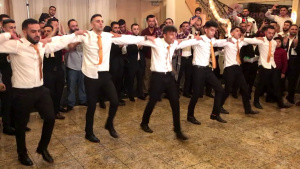Language/Standard-arabic/Culture/Dabke-dance
The Dabke (Arabic: دبکة, "kick") is a type of male folk dance known in the Levant, with several regional versions. It is a line group dance where the dancers hold hands and strike the ground hard. It is most often danced at weddings, banquets and occasional parties. It can last two hours or more.
- Dabke is a way of expressing joy and happiness for Arabs.
- When a person graduates or gets married, it is better to do Dabke or the party might be boring.
- Not all Arabs do Dabke. It only exists in certain parts of the Middle East such as Jordan, Syria and Lebanon. It is rare to see it in the Gulf countries or in South Africa which have their own way of dancing.
Take a moment to explore these relevant pages as you conclude this lesson: Standard Arabic Culture → Arabic music and entertainment ..., Standard Arabic Culture → Arabic music and entertainment ..., Celebrations and events: Ramadan and Eid & History of Arabic calligraphy.
Origin[edit | edit source]
Most sources agreed that the dance form that’s later known as dabke appeared in the mountainous areas around the Mediterranean coastline and the Tigris river. Some of the earliest adopters of the dance were the people in villages in the Levant (Lebanon, Syria, Palestine, Jordan, Iraq) as well as certain Bedouin tribes in the regions.
Videos[edit | edit source]
Lebanese Dabke[edit | edit source]
Free Style Palestinian/Lebanese Dabke[edit | edit source]
Other Lessons[edit | edit source]
- Why Learn Arabic
- Hot Mood
- Jordan Timeline
- Most Delicious Arabic Dishes
- Iraq Timeline
- Television
- The Arabic language
- Bahrain Timeline
- Kuwait Timeline



